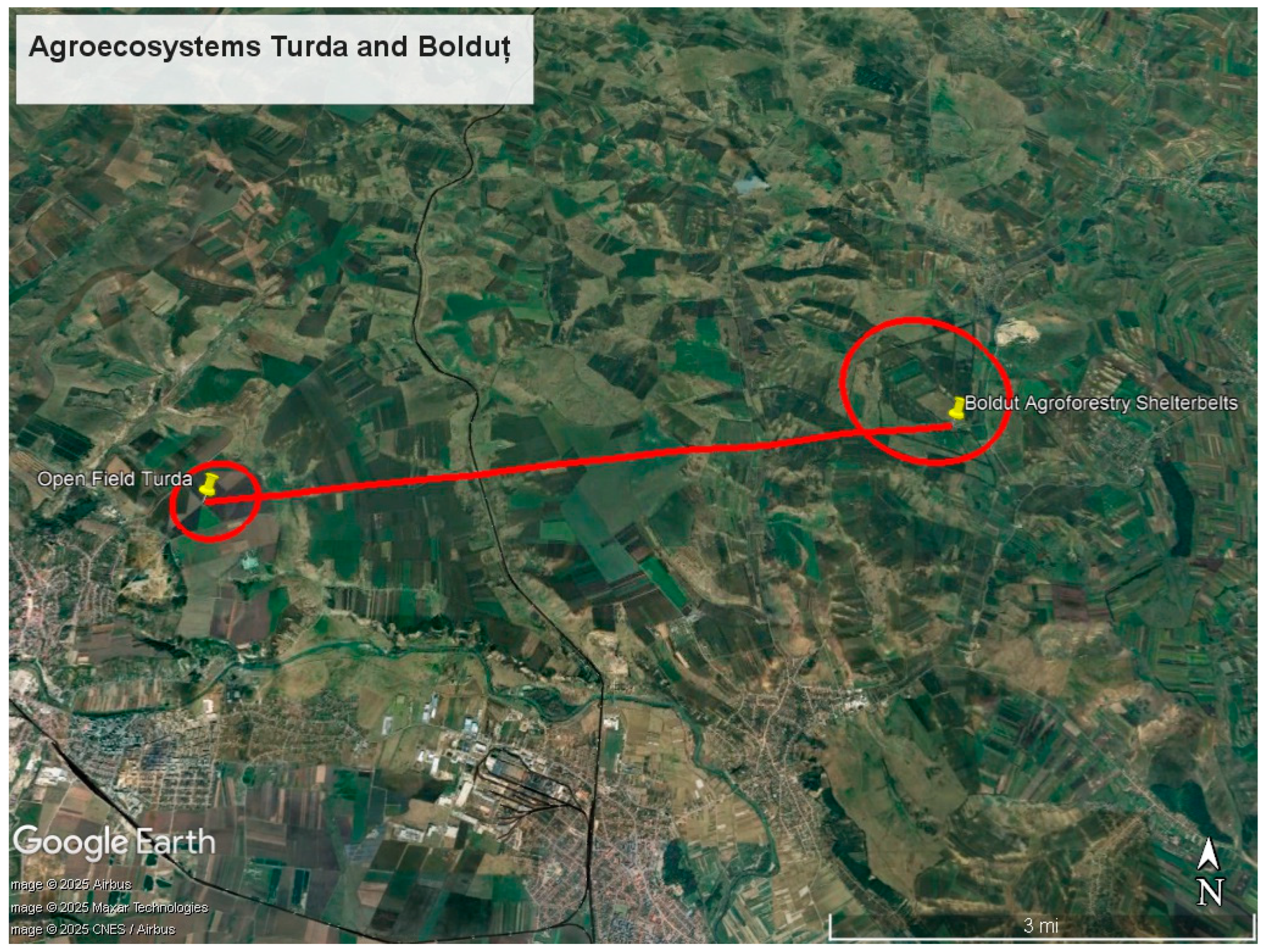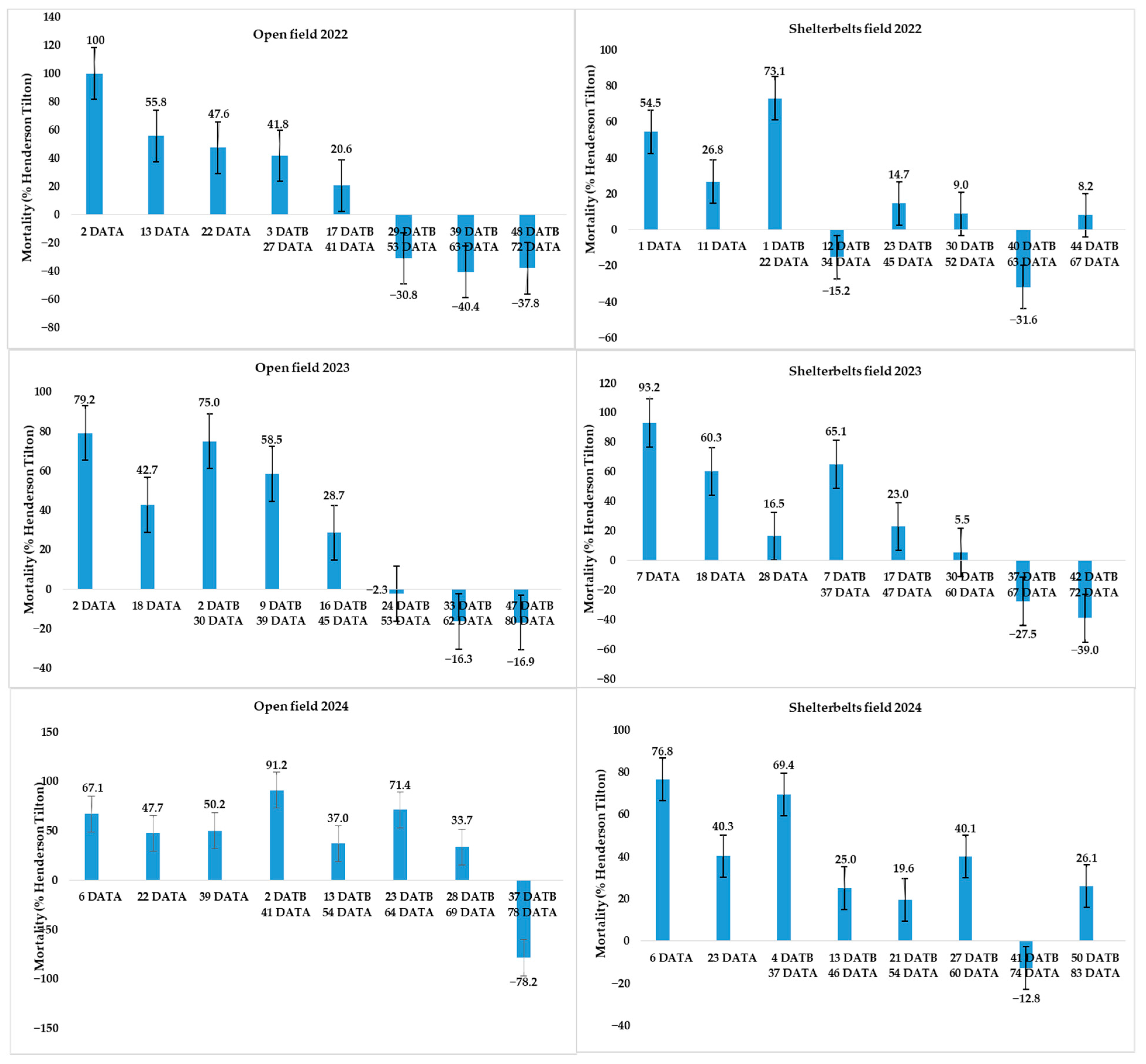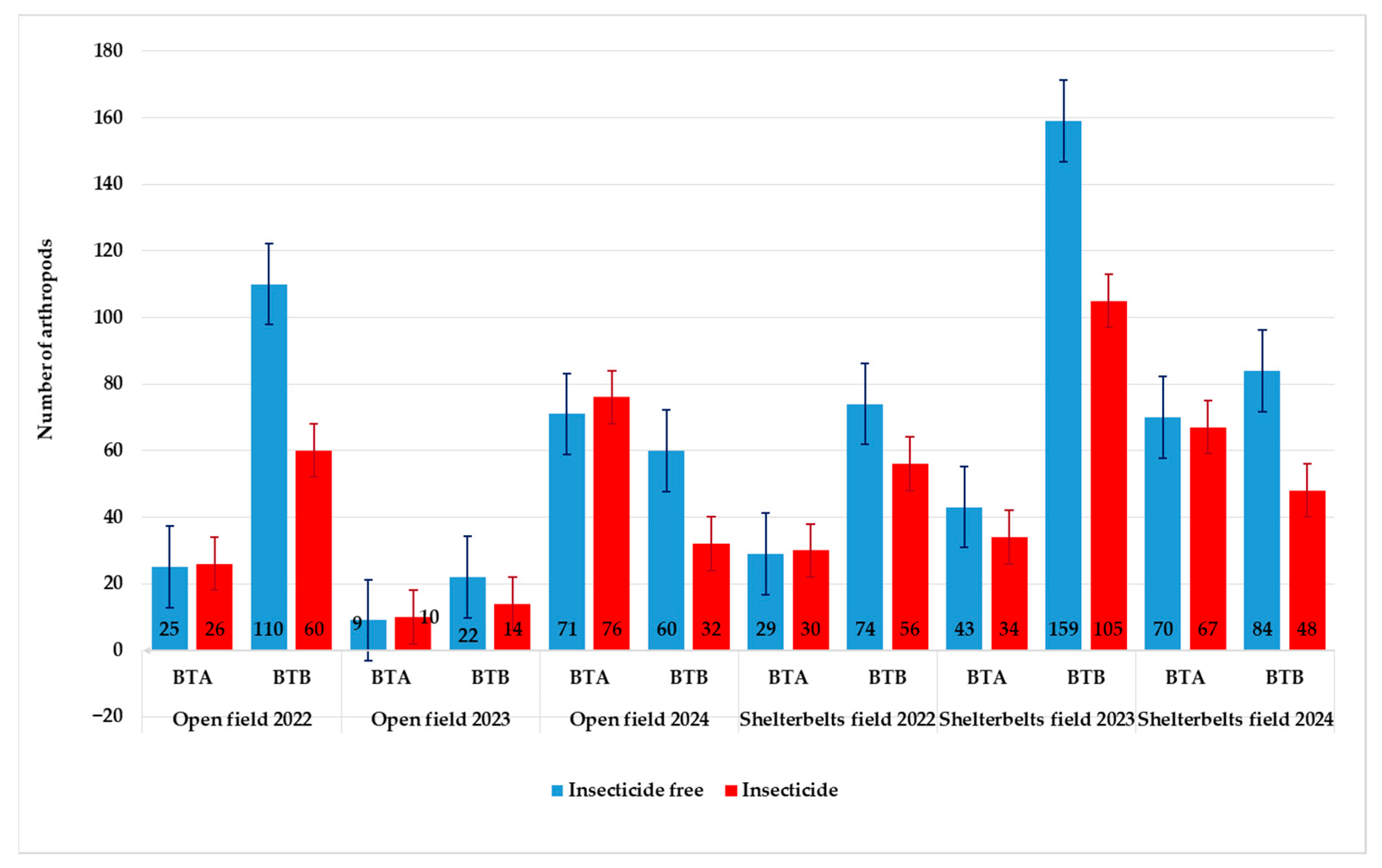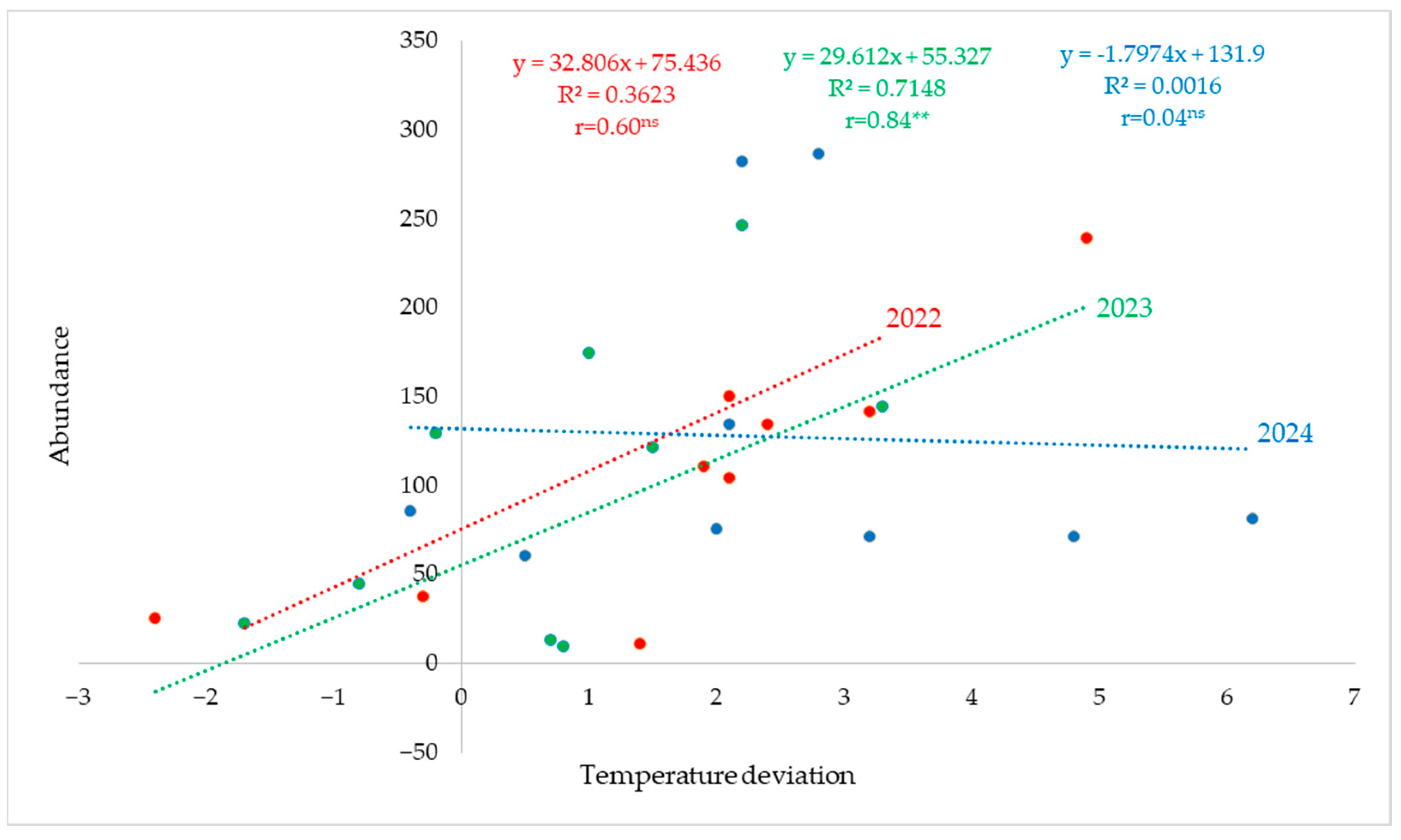Impact of Shelterbelts on the Diversity and Dynamics of Natural Enemies in Wheat Agroecosystems
Abstract
1. Introduction
2. Materials and Methods
2.1. Study Site
2.2. Pesticides Used in the Experiment
2.3. Natural Enemies—Sampling
2.4. Climate Conditions During the Experimental Period
3. Results
3.1. Results on Natural Enemies Abundance
3.2. Results on Diversity and Evenness Indices
3.3. Results on Natural Enemies Mortality
4. Discussion
5. Conclusions
Supplementary Materials
Author Contributions
Funding
Data Availability Statement
Acknowledgments
Conflicts of Interest
References
- FAOSTAT. Available online: https://www.fao.org/faostat/en/#data/QCL (accessed on 24 July 2025).
- Curtis, T.; Halford, N.G. Food Security: The Challenge of Increasing Wheat Yield and the Importance of Not Compromising Food Safety. Ann. Appl. Biol. 2014, 164, 354–372. [Google Scholar] [CrossRef]
- Biel, W.; Kazimierska, K. Nutritional Value of Wheat, Triticale, Barley and Oat Grains. Acta Sci. Pol. Zootech. 2020, 19, 19–28. [Google Scholar] [CrossRef]
- Shiferaw, B.; Smale, M.; Braun, H.-J.; Duveiller, E.; Reynolds, M.; Muricho, G. Crops That Feed the World 10. Past Successes and Future Challenges to the Role Played by Wheat in Global Food Security. Food Secur. 2013, 5, 291–317. [Google Scholar] [CrossRef]
- Farook, U.B.; Khan, Z.H.; Ahad, I.; Maqbool, S.; Yaqoob, M.; Rafieq, I.; Rehman, S.A.; Sultan, N. A Review on Insect Pest Complex of Wheat. J. Entomol. Zool. Stud. 2019, 7, 1292–1298. [Google Scholar]
- Qayyum, M.A.; Saeed, S.; Naeem-Ullah, U.; Matloob, A.; Wajid, M.; Siddique, A.B.; Shahid, R.; Zia, H.U.U.R.; Bilal, H.; Ramzan, M.; et al. Insect Pest Complex of Wheat Crop. In Current Trends in Wheat Research; IntechOpen: London, UK, 2021; ISBN 978-1-83968-594-1. [Google Scholar]
- Rusch, A.; Bommarco, R.; Ekbom, B. Chapter Ten—Conservation Biological Control in Agricultural Landscapes. In Advances in Botanical Research; Sauvion, N., Thiéry, D., Calatayud, P.-A., Eds.; Insect-Plant Interactions in a Crop Protection Perspective; Academic Press: Cambridge, MA, USA, 2017; Volume 81, pp. 333–360. [Google Scholar]
- Brzozowski, L.; Mazourek, M. A Sustainable Agricultural Future Relies on the Transition to Organic Agroecological Pest Management. Sustainability 2018, 10, 2023. [Google Scholar] [CrossRef]
- Nchu, F. Sustainable Biological Control of Pests: The Way Forward. Appl. Sci. 2024, 14, 2669. [Google Scholar] [CrossRef]
- Snyder, W.E.; Ives, A.R. Interactions Between Specialist and Generalist Natural Enemies: Parasitoids, Predators, and Pea Aphid Biocontrol. Ecology 2003, 84, 91–107. [Google Scholar] [CrossRef]
- Baker, B.P.; Green, T.A.; Loker, A.J. Biological Control and Integrated Pest Management in Organic and Conventional Systems. Biol. Control 2020, 140, 104095. [Google Scholar] [CrossRef]
- McCravy, K.W. A Review of Sampling and Monitoring Methods for Beneficial Arthropods in Agroecosystems. Insects 2018, 9, 170. [Google Scholar] [CrossRef] [PubMed]
- Del-Val, E.; Ramírez, E.; Astier, M. Comparison of Arthropod Communities Between High and Low Input Maize Farms in Mexico. CABI Agric. Biosci. 2021, 2, 40. [Google Scholar] [CrossRef]
- Botha, M.; Siebert, S.; Van den Berg, J.; Ellis, S.; Greyvenstein, B. Diversity Patterns of Selected Predaceous Arthropod Groups in Maize Fields and Margins in South African Highveld Grassland: Predaceous Arthropods of Maize Agro-Ecosystems. Agric. For. Entomol. 2018, 20, 461–475. [Google Scholar] [CrossRef]
- Elhamalawy, O.; Bakr, A.; Eissa, F. Impact of Pesticides on Non-Target Invertebrates in Agricultural Ecosystems. Pestic. Biochem. Physiol. 2024, 202, 105974. [Google Scholar] [CrossRef]
- Nyffeler, M.; Sunderland, K. Composition, Abundance and Pest Control Potential of Spider Communities in Agroecosystems: A Comparison of European and US Studies. Agric. Ecosyst. Environ. 2003, 95, 579–612. [Google Scholar] [CrossRef]
- Michalko, R.; Pekar, S.; Entling, M. An Updated Perspective on Spiders as Generalist Predators in Biological Control. Oecologia 2019, 189, 21–36. [Google Scholar] [CrossRef]
- Finke, D.; Denno, R. Predator Diversity and the Functioning of Ecosystems: The Role of Intraguild Predation in Dampening Trophic Cascades. Ecol. Lett. 2005, 8, 1299–1306. [Google Scholar] [CrossRef]
- Cotes, B.; González, M.; Benítez, E.; De Mas, E.; Clemente-Orta, G.; Campos, M.; Rodríguez, E. Spider Communities and Biological Control in Native Habitats Surrounding Greenhouses. Insects 2018, 9, 33. [Google Scholar] [CrossRef]
- Jarpla, M.; Kumari, P.; Pawar, P.; Reddy, N.; Bhargavi, C.; Samreen, M.; Aniket, E.V. A Review on Role of Beneficial Insects in Sustainable Crop Production Systems. J. Exp. Agric. Int. 2024, 46, 687–699. [Google Scholar] [CrossRef]
- Malschi, D. Integrated Pest Management in Relation to Environmental Sustainability. Course Notes and Practical Applications: [Online Manual] Part I, Ecological Management of Wheat Pests; Bioflux: Cluj-Napoca, Romania, 2009; ISBN 978-606-92028-3-8. [Google Scholar]
- Popov, C. List of Species of Parasites and Predators of the Cereal Bugs of the Genus Eurygaster Spp., Aelia Spp. Probl. Prot. Plantelor 1999, XXVII, 57–74. [Google Scholar]
- Popov, C.; Cană, L.; Georgescu, E. Rolul Indicatorilor De Biodiversitate in Aprecierea Managementului Dăunătorilor din Cultura Grâului. An. INCDA Fundulea 2009, 77, 199–210. [Google Scholar]
- Schipper, C.A.; Hielkema, T.W.; Ziemba, A. Impact of Climate Change on Biodiversity and Implications for Nature-Based Solutions. Climate 2024, 12, 179. [Google Scholar] [CrossRef]
- Yan, B.; Cui, Y.; Fan, M.; Li, Z.; Sun, L.; Chang, X. Inhibition of Soil Wind-Erosion and Dust by Shelterbelts in the Hilly Area of Loess Plateau and Its Influencing Factors. Forests 2024, 15, 1413. [Google Scholar] [CrossRef]
- Dong, Z.; Ouyang, F.; Lv, F.; Ge, F. Shelterbelts in Agricultural Landscapes Enhance Ladybeetle Abundance in Spillover from Cropland to Adjacent Habitats. BioControl 2015, 60, 351–361. [Google Scholar] [CrossRef]
- N’Woueni, D.K.; Gaoue, O.G. Plant Diversity Increased Arthropod Diversity and Crop Yield in Traditional Agroforestry Systems but Has No Effect on Herbivory. Sustainability 2022, 14, 2942. [Google Scholar] [CrossRef]
- Bentrup, G.; Hopwood, J.; Adamson, N.L.; Vaughan, M. Temperate Agroforestry Systems and Insect Pollinators: A Review. Forests 2019, 10, 981. [Google Scholar] [CrossRef]
- Enescu, C.M.; Mihalache, M.; Ilie, L.; Dinca, L.; Constandache, C.; Murariu, G. Agricultural Benefits of Shelterbelts and Windbreaks: A Bibliometric Analysis. Agriculture 2025, 15, 1204. [Google Scholar] [CrossRef]
- Malschi, D.; Tărău, A.D.; Vălean, A.M.; Şopterean, L.; Suciu, A.L.; Dărab, I.D.; Chețan, C.; Tritean, N. Wheat Pest Dynamics, Forecasting and Current Importance of the Attack, to Develop Integrated Control System in the Center of Transylvania (ARDS Turda, 2006–2016). Rom. Agric. Res. 2018, 35, 203–220. [Google Scholar] [CrossRef]
- Vălean, A.-M.; Malschi, D.; Mureşanu, F.; Şopterean, L.; Suciu, L.; Russu, F.; Porumb, I.; Oltean, I. Identification and Monitoring of Useful Enthomophagous Arthropods Fauna from the Winter Wheat Crop in Two Agroecosistems from the Center of Transylvania. Manag. Econ. Eng. Agric. Rural. Dev. 2018, 18, 515–522. [Google Scholar]
- Valean, A.-M.; Malschi, D.; Russu, F.; Tarau, A.; Sopterean, L.; Suciu, L.; Oltean, I. The Importance of Useful Arthropod Fauna in Limiting Wheat Pests in the Center of Transylvania. LIFE Sci. Sustain. Dev. 2021, 2, 128–134. [Google Scholar] [CrossRef]
- Bucurean, E.; Marnea, I.A. Research Regarding Pest Insect Fauna and Polyphagous Predators in Grains Cereal Crops in The Western Part of The Country. Analele Univ. Oradea Fasc. Prot. Mediu. 2013, XXI, 27–32. [Google Scholar]
- Mayrinck, R.C.; Laroque, C.P.; Amichev, B.Y.; Van Rees, K. Above- and Below-Ground Carbon Sequestration in Shelterbelt Trees in Canada: A Review. Forests 2019, 10, 922. [Google Scholar] [CrossRef]
- Malschi, D.; Tărău, A.; Kadar, R.; Tritean, N.; Cheţan, C. Climate Warming in Relation to Wheat Pest Dynamics and Their Integrated Control in Transylvanian Crop Management Systems with No Tillage and with Agroforestry Belts. Rom. Agric. Res. 2015, 32, 279–289. [Google Scholar]
- Staton, T.; Walters, R.; Smith, J.; Breeze, T.; Girling, R. Management to Promote Flowering Understoreys Benefits Natural Enemy Diversity, Aphid Suppression and Income in an Agroforestry System. Agronomy 2021, 11, 651. [Google Scholar] [CrossRef]
- Nair, P.R. The Coming of Age of Agroforestry. J. Sci. Food Agric. 2007, 87, 1613–1619. [Google Scholar] [CrossRef]
- Jose, S. Agroforestry for Ecosystem Services and Environmental Benefits: An Overview. Agrofor. Syst. 2009, 76, 1–10. [Google Scholar] [CrossRef]
- Monnette, P.; Hobbs, J. A Guide to Hedgerows: Plantings That Enhance Biodiversity, Sustainability and Functionality. Available online: https://extension.oregonstate.edu/pub/em-8721 (accessed on 24 July 2025).
- Ramachandran Nair, P.K. Agroforestry: Trees in Support of Sustainable Agriculture☆. In Reference Module in Earth Systems and Environmental Sciences; Elsevier: Amsterdam, The Netherlands, 2013; ISBN 978-0-12-409548-9. [Google Scholar]
- Hatt, S.; Boeraeve, F.; Artru, S.; Dufrêne, M.; Francis, F. Spatial Diversification of Agroecosystems to Enhance Biological Control and Other Regulating Services: An Agroecological Perspective. Sci. Total Environ. 2018, 621, 600–611. [Google Scholar] [CrossRef] [PubMed]
- Van Stappen, F.; Loriers, A.; Mathot, M.; Planchon, V.; Stilmant, D.; Debode, F. Organic Versus Conventional Farming: The Case of Wheat Production in Wallonia (Belgium). Agric. Agric. Sci. Procedia 2015, 7, 272–279. [Google Scholar] [CrossRef]
- Jańczak-Pieniążek, M.; Buczek, J.; Kwiatkowski, C.A.; Harasim, E. The Course of Physiological Processes, Yielding, and Grain Quality of Hybrid and Population Wheat as Affected by Integrated and Conventional Cropping Systems. Agronomy 2022, 12, 1345. [Google Scholar] [CrossRef]
- Magurran, A.E. Measuring Biological Diversity; Blackwell Publishing: Oxford, UK, 2004; 256p, Available online: https://www.scirp.org/reference/referencespapers?referenceid=1371188 (accessed on 24 July 2025).
- Aydın, G. Comparison of Insect Biological Diversity Parameters in Natural and Degraded Habitats in Gölcük Nature Park (Isparta, Turkey). Turk. J. For. 2021, 22, 362–365. [Google Scholar] [CrossRef]
- Bangels, E.; Peusens, G.; Beliën, T.; Gobin, B. Compatibility of Spirotetramat (Movento®) in Integrated Pome Fruit Production. Acta Hortic. 2011, 917, 77–83. [Google Scholar] [CrossRef]
- Prazaru, S.C.; D’Ambrogio, L.; Dal Cero, M.; Rasera, M.; Cenedese, G.; Guerrieri, E.; Pavasini, M.; Mori, N.; Pavan, F.; Duso, C. Efficacy of Conventional and Organic Insecticides against Scaphoideus titanus: Field and Semi-Field Trials. Insects 2023, 14, 101. [Google Scholar] [CrossRef] [PubMed]
- Skendžić, S.; Zovko, M.; Živković, I.P.; Lešić, V.; Lemić, D. The Impact of Climate Change on Agricultural Insect Pests. Insects 2021, 12, 440. [Google Scholar] [CrossRef] [PubMed]
- Sharma, H.C.; Prabhakar, C.S. Chapter 2-Impact of Climate Change on Pest Management and Food Security. In Integrated Pest Management; Abrol, D.P., Ed.; Academic Press: San Diego, CA, USA, 2014; pp. 23–36. ISBN 978-0-12-398529-3. [Google Scholar]
- Călugăr, R.E.; Varga, A.; Vana, C.D.; Ceclan, L.A.; Racz, I.; Chețan, F.; Șimon, A.; Popa, C.; Tritean, N.; Russu, F.; et al. Influence of Changing Weather on Old and New Maize Hybrids: A Case Study in Romania. Plants 2024, 13, 3322. [Google Scholar] [CrossRef]
- Bale, J.S.; Hayward, S.A.L. Insect Overwintering in a Changing Climate. J. Exp. Biol. 2010, 213, 980–994. [Google Scholar] [CrossRef] [PubMed]
- Meteo Romania | Site-ul Administratiei Nationale de Meteorologie. Available online: https://www.meteoromania.ro/ (accessed on 24 July 2025).
- Zhang, H.; Xu, D.; Deng, X.; Liu, Z.; He, Z.; Wu, J.; Zhuo, Z. Impact of Temperature Variation on the Biological Traits and Lifecycle of Spodoptera exigua (Lepidoptera: Noctuidae): A Meta-Analysis Approach. Insects 2025, 16, 155. [Google Scholar] [CrossRef] [PubMed]
- Barrios, E.; Valencia, V.; Jonsson, M.; Brauman, A.; Hairiah, K.; Mortimer, P.; Okubo, S. Contribution of Trees to the Conservation of Biodiversity and Ecosystem Services in Agricultural Landscapes. Int. J. Biodivers. Sci. Ecosyst. Serv. Manag. 2017, 14, 1–16. [Google Scholar] [CrossRef]
- Eitzinger, B.; Traugott, M. Which Prey Sustains Cold-adapted Invertebrate Generalist Predators in Arable Land? Examining Prey Choices by Molecular Gut-content Analysis. J. Appl. Ecol. 2011, 48, 591–599. [Google Scholar] [CrossRef]
- Altaf, M.U.; Mukhtar, A.; Batool, M.; Zaka, S.M.; Azad, R.; Hameed, Y.; Tajdar, A.; Ali, A.; Jaleel, W. Predatory Behavior of Coccinella septempunctata on Two Different Aphid Species via Functional Response at Two Different Temperatures. Biology 2025, 14, 245. [Google Scholar] [CrossRef]
- Sunderland, K.D.; Fraser, A.M.; Dixon, A.F.G. Field and Laboratory Studies on Money Spiders (Linyphiidae) as Predators of Cereal Aphids. J. Appl. Ecol. 1986, 23, 433–447. [Google Scholar] [CrossRef]
- Lang, A. Intraguild Interference and Biocontrol Effects of Generalist Predators in a Winter Wheat Field. Oecologia 2003, 134, 144–153. [Google Scholar] [CrossRef] [PubMed]
- Sunderland, K.; Samu, F. Effects of Agricultural Diversification on the Abundance, Distribution, and Pest Control Potential of Spiders: A Review. Entomol. Exp. Appl. 2000, 95, 1–13. [Google Scholar] [CrossRef]
- Garratt, M.P.D.; Senapathi, D.; Coston, D.J.; Mortimer, S.R.; Potts, S.G. The Benefits of Hedgerows for Pollinators and Natural Enemies Depends on Hedge Quality and Landscape Context. Agric. Ecosyst. Environ. 2017, 247, 363–370. [Google Scholar] [CrossRef]
- Liu, Y.; Dong, J.; Chi, B.; Liu, Y. Thermal Activity Thresholds of Parasitoids Aphidius avenae and Aphidius gifuensis (Hymenoptera: Braconidae): Implications for Their Efficacy as Biological Control Agents in the Same Location. Fla. Entomol. 2016, 99, 691–695. [Google Scholar] [CrossRef]
- Lau, D.; Sampaio, M.V.; Salvadori, J.R.; da Silva Pereira, P.R.V.; dos Santos, C.D.R.; Engel, E.; Panizzi, A.R.; Marsaro Júnior, A.L. Historical and Contemporary Perspectives on the Biological Control of Aphids on Winter Cereals by Parasitoids in South America. Neotrop. Entomol. 2023, 52, 172–188. [Google Scholar] [CrossRef]
- Santini, L.; Belmaker, J.; Costello, M.J.; Pereira, H.M.; Rossberg, A.G.; Schipper, A.M.; Ceaușu, S.; Dornelas, M.; Hilbers, J.P.; Hortal, J.; et al. Assessing the Suitability of Diversity Metrics to Detect Biodiversity Change. Biol. Conserv. 2017, 213, 341–350. [Google Scholar] [CrossRef]
- Vizitiu, D.E.; Sardarescu, I.-D.; Buciumeanu, E.C.; Guta, I.-C.; Dincă, L.; Bălăcenoiu, F.; Toma, D.; Crișan, V.; Din, A. The Influence of Groves on Aboveground Arthropod Diversity and Evolution in a Vineyard in Southern Romania. Sustainability 2023, 15, 16543. [Google Scholar] [CrossRef]
- Quandahor, P.; Kim, L.; Kim, M.; Lee, K.; Kusi, F.; Jeong, I. Effects of Agricultural Pesticides on Decline in Insect Species and Individual Numbers. Environments 2024, 11, 182. [Google Scholar] [CrossRef]
- Desneux, N.; Decourtye, A.; Delpuech, J.-M. The Sublethal Effects of Pesticides on Beneficial Arthropods. Annu. Rev. Entomol. 2007, 52, 81–106. [Google Scholar] [CrossRef] [PubMed]
- Biondi, A.; Desneux, N.; Siscaro, G.; Zappalà, L. Using Organic-Certified Rather than Synthetic Pesticides May Not Be Safer for Biological Control Agents: Selectivity and Side Effects of 14 Pesticides on the Predator Orius laevigatus. Chemosphere 2012, 87, 803–812. [Google Scholar] [CrossRef] [PubMed]
- Gagic, V.; Hulthen, A.D.; Marcora, A.; Wang, X.; Jones, L.; Schellhorn, N.A. Biocontrol in insecticide sprayed crops does not benefit from semi-natural habitats and recovers slowly after spraying. J. Appl. Ecol. 2019, 56, 2176–2185. [Google Scholar] [CrossRef]
- Zilnik, G.; Bergeron, P.E.; Chuang, A.; Diepenbrock, L.; Hanel, A.; Middleton, E.; Moretti, E.; Schmidt-Jeffris, R. Meta-Analysis of Herbicide Non-Target Effects on Pest Natural Enemies. Insects 2023, 14, 787. [Google Scholar] [CrossRef] [PubMed]








| 2022 | 2023 | 2024 | |
|---|---|---|---|
| Fertilizers administered | NPK 1 (16:16:16) 300 kg/ha−1 Nitrocalcar 3 (27% s.a) 200 kg/ha−1 | NPK (20:20:0) 300 kg/ha−1 UREE 4 (46% s.a) 100 kg/ha−1 | NP 2 20:20:13 Sulfur −200 kg/ha−1 Nitrocalcar (27% s.a) 200 kg/ha−1 |
| Foliar fertilizer | Tonivit 5 (1 L/ha−1) [TA] | Tonivit (1 L/ha−1) [TA] | Maxigrow 6 (600 mL/ha−1) [TA] |
| Herbicides | Sekator 7 (100 g/amidosulfuron 25 g/L iodosulfuron-metil-Na 250 g/L mefenpyr dietil) 0.15 L/ha−1 [TA] Amino 600 SL 9 (600 g/L acid 2.4-D) 1 L/ha−1 [TA] | Brodwaystar 8 (piroxsulam 70.8 g + florasulam 14.2 g + cloquintocet mexil (safener) 70.8 g) 250 g/ha−1 [TA] Amino 600 SL (600 g/L acid 2.4-D) 1 L/ha−1 [TA] | Brodwaystar (piroxsulam 70.8 g + florasulam 14.2 g + cloquintocet mexil (safener) 70.8 g) 250 g/ha−1 [TA] Amino 600 SL (600 g/L acid 2.4-D) 1 L/ha−1 [TA] |
| Fungicides | Falcon PRO 10 (53 g/L protioconazol 224 g/L spiroxamină 148 g/L tebuconazol) 0.8 L/ha−1 [TA] Nativo 12 (175 g/L protioconazol 150 g/L trifloxistrobin) 0.8 L/ha−1 [TB] | Falcon PRO (53 g/L protioconazol 224 g/L spiroxamină 148 g/L tebuconazol) 0.8 L/ha−1 [TA] Nativo 175 g/L protioconazol 150 g/L trifloxistrobin 0.8 L/ha−1 [TB] | Flexity 300 SC 11 (300 g/L Metrafenonă) 0.25 L/ha−1 [TA] Mizona 13 (200 g/L piraclostrobin, 30 g/L fluxapiroxad) 0.5 L/ha−1 [TA] Revycare 14 (100 g/L mefentrifluconazol, 100 g/L piraclostrobin 1 L/ha−1 [TB] |
| Insecticides | APIS 200 SE 15 (200 g/L acetamiprid) 0.15 L/ha−1 [TA] Evure (tau-fluvalinat 240 g/L) 0.2 L/ha−1 [TB] | APIS 200 SE (200 g/L acetamiprid) 0.15 L/ha−1 [TA] Evure (tau-fluvalinat 240 g/L) 0.2 L/ha−1 [TB] | APIS 200 SE (200 g/L acetamiprid) 0.15 L/ha−1 [TA] Mavrik (tau-fluvalinat 240 g/L) 0.2 L/ha−1 [TB] |
| Adjuvant | Trend 16 (1 L/ha−1) [TA]; [TB] | Dassoil 17 (0.6 L/ha−1) [TA] Vital 18 (100 mL in 100 L water) [TB] | Dassoil (0.6 L/ha−1) [TA] Inex 19 0.25 L/ha−1 [TB] |
| Families/Species | Open-Field Agroecosystem | Shelterbelt Field Agroecosystem | ||||||||||
|---|---|---|---|---|---|---|---|---|---|---|---|---|
| Insecticides-Free Plot | Insecticides Plot | Insecticides-Free Plot | Insecticides Plot | |||||||||
| 2022 | 2023 | 2024 | 2022 | 2023 | 2024 | 2022 | 2023 | 2024 | 2022 | 2023 | 2024 | |
| Coccinella 7—punctata L. | 10 | 9 | 33 | 5 | 7 | 1 | 23 | 24 | 34 | 13 | 12 | 13 |
| Propylaea 14—punctata L. | 4 | 2 | 4 | 3 | 2 | 0 | 10 | 9 | 8 | 8 | 2 | 3 |
| Other Coccinellidae Species | 0 | 0 | 0 | 0 | 0 | 0 | 11 | 6 | 1 | 5 | 5 | 0 |
| Cantharis fusca L. | 36 | 38 | 29 | 19 | 24 | 3 | 38 | 59 | 31 | 30 | 24 | 12 |
| Other Cantharidae Species | 31 | 0 | 0 | 18 | 0 | 0 | 109 | 87 | 0 | 18 | 37 | 0 |
| Malachius bipustulatus L. | 10 | 12 | 15 | 5 | 6 | 3 | 18 | 14 | 23 | 6 | 8 | 6 |
| Nabis ferus L. | 59 | 75 | 271 | 30 | 21 | 71 | 85 | 82 | 289 | 66 | 52 | 101 |
| Other Nabidae Species | 0 | 0 | 0 | 0 | 0 | 0 | 0 | 10 | 0 | 0 | 29 | 36 |
| Orius spp. | 1 | 0 | 2 | 1 | 0 | 0 | 9 | 3 | 4 | 5 | 2 | 2 |
| Anthocoris spp. | 0 | 1 | 0 | 1 | 0 | 1 | 6 | 3 | 5 | 4 | 3 | 3 |
| Adelphocoris spp. | 0 | 0 | 1 | 0 | 0 | 1 | 1 | 2 | 4 | 1 | 1 | 3 |
| Tachyporus hypnorum F. | 0 | 0 | 0 | 0 | 0 | 3 | 0 | 0 | 7 | 0 | 0 | 2 |
| Staphylinus spp. | 0 | 0 | 5 | 0 | 0 | 1 | 8 | 0 | 6 | 7 | 0 | 1 |
| Chrysopa carnea S. | 20 | 21 | 11 | 9 | 11 | 8 | 20 | 46 | 5 | 18 | 33 | 4 |
| Episyrphus balteatus DeGeer | 0 | 3 | 16 | 0 | 1 | 5 | 1 | 3 | 9 | 0 | 2 | 2 |
| Other Syrphidae Species | 83 | 93 | 17 | 40 | 49 | 3 | 133 | 132 | 77 | 49 | 57 | 7 |
| Tachinidae spp. | 0 | 0 | 0 | 0 | 0 | 0 | 9 | 0 | 0 | 0 | 0 | 0 |
| Platypalpus spp. | 139 | 157 | 85 | 60 | 73 | 29 | 177 | 152 | 244 | 130 | 71 | 109 |
| Other Empididae Species | 0 | 0 | 0 | 0 | 0 | 0 | 0 | 138 | 0 | 0 | 55 | 0 |
| Collyria coxator Villers | 2 | 5 | 8 | 0 | 2 | 2 | 8 | 9 | 2 | 8 | 2 | 1 |
| Aphydius avenae Haliday | 4 | 37 | 14 | 1 | 21 | 0 | 49 | 48 | 15 | 29 | 26 | 5 |
| Other Parasitic Hymenoptera Species | 69 | 96 | 207 | 53 | 59 | 74 | 151 | 101 | 213 | 264 | 61 | 111 |
| Order Araneae | 483 | 353 | 337 | 345 | 231 | 233 | 995 | 746 | 444 | 698 | 501 | 219 |
| No. of total individuals | 951 | 902 | 1055 | 590 | 507 | 438 | 1861 | 1674 | 1421 | 1359 | 983 | 640 |
| Open-Field Agroecosystem | Shelterbelt Field Agroecosystem | |||||||||||
|---|---|---|---|---|---|---|---|---|---|---|---|---|
| Insecticides-Free Plot | Insecticides Plot | Insecticides-Free Plot | Insecticides Plot | |||||||||
| 2022 | 2023 | 2024 | 2022 | 2023 | 2024 | 2022 | 2023 | 2024 | 2022 | 2023 | 2024 | |
| Taxa_S | 14 | 14 | 16 | 14 | 13 | 13 | 20 | 20 | 19 | 18 | 20 | 19 |
| Individuals | 951 | 902 | 1055 | 590 | 507 | 436 | 1861 | 1674 | 1421 | 1360 | 983 | 640 |
| Dominance_D | 0.2992 | 0.2166 | 0.2158 | 0.3699 | 0.2577 | 0.346 | 0.3137 | 0.2318 | 0.1955 | 0.3154 | 0.2831 | 0.2054 |
| Simpson_1-D | 0.7008 | 0.7834 | 0.7842 | 0.6301 | 0.7423 | 0.654 | 0.6863 | 0.7682 | 0.8045 | 0.6846 | 0.7169 | 0.7946 |
| Shannon_H | 1.68 | 1.875 | 1.841 | 1.518 | 1.772 | 1.426 | 1.765 | 2.023 | 1.918 | 1.654 | 1.911 | 1.892 |
| Evenness_e^H/S | 0.3831 | 0.4659 | 0.3938 | 0.3258 | 0.4526 | 0.3201 | 0.292 | 0.3782 | 0.3581 | 0.2905 | 0.3379 | 0.349 |
| Equitability_J | 0.6364 | 0.7106 | 0.6639 | 0.5751 | 0.6909 | 0.5559 | 0.589 | 0.6754 | 0.6513 | 0.5723 | 0.6378 | 0.6425 |
| Chao-1 | 14 | 14 | 16 | 17 | 13 | 13.5 | 21 | 20 | 19 | 18 | 20 | 19.25 |
Disclaimer/Publisher’s Note: The statements, opinions and data contained in all publications are solely those of the individual author(s) and contributor(s) and not of MDPI and/or the editor(s). MDPI and/or the editor(s) disclaim responsibility for any injury to people or property resulting from any ideas, methods, instructions or products referred to in the content. |
© 2025 by the authors. Licensee MDPI, Basel, Switzerland. This article is an open access article distributed under the terms and conditions of the Creative Commons Attribution (CC BY) license (https://creativecommons.org/licenses/by/4.0/).
Share and Cite
Vălean, A.-M.; Suciu, L.; Tărău, A.; Șopterean, L.; Russu, F.; Șimon, A.; Chețan, F.; Tritean, N. Impact of Shelterbelts on the Diversity and Dynamics of Natural Enemies in Wheat Agroecosystems. Agronomy 2025, 15, 2153. https://doi.org/10.3390/agronomy15092153
Vălean A-M, Suciu L, Tărău A, Șopterean L, Russu F, Șimon A, Chețan F, Tritean N. Impact of Shelterbelts on the Diversity and Dynamics of Natural Enemies in Wheat Agroecosystems. Agronomy. 2025; 15(9):2153. https://doi.org/10.3390/agronomy15092153
Chicago/Turabian StyleVălean, Ana-Maria, Loredana Suciu, Adina Tărău, Laura Șopterean, Florin Russu, Alina Șimon, Felicia Chețan, and Nicolae Tritean. 2025. "Impact of Shelterbelts on the Diversity and Dynamics of Natural Enemies in Wheat Agroecosystems" Agronomy 15, no. 9: 2153. https://doi.org/10.3390/agronomy15092153
APA StyleVălean, A.-M., Suciu, L., Tărău, A., Șopterean, L., Russu, F., Șimon, A., Chețan, F., & Tritean, N. (2025). Impact of Shelterbelts on the Diversity and Dynamics of Natural Enemies in Wheat Agroecosystems. Agronomy, 15(9), 2153. https://doi.org/10.3390/agronomy15092153







